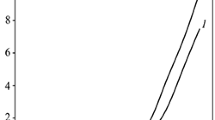Conducting coatings for photovoltaic cells containing carbon nanotubes and other carbon nanostructures and SnO2 were obtained. The surface of coating samples at all stages of synthesis was studied by means of a complex of mutually complementary physical-chemical methods of investigating the composition and structure of matter and materials: x-ray phase analysis (XPA), scanning electron microscopy (SEM), atomic-force microscopy (AFM), optical microscopy, and UV- and visible-range spectroscopy. In addition, measurements of the surface resistance of the coatings obtained were performed. It was determined that the obtained coatings SnO2– nanocarbon material based on nanotubes possessed the lowest electrical resistance.




Similar content being viewed by others
References
Z. C. Wu, Z. H. Chen, X. Du, et al., “Transparent, conductive carbon nanotube films,” Science, 305, 1273 – 1276 (2004).
A. Rahy, P. Bajaj, I. H. Musselman, et al., “Coating of carbon nanotubes on flexible substrate and its adhesion study,” Appl. Surf. Sci., 255(15), 7084 – 7089 (2009).
D. S. Hecht, L. B. Hu, and G. Irvin, “Emerging transparent electrodes based on thin films of carbon nanotubes, graphene, and metallic nanostructures,” Adv. Mater., No. 3(13), 482 – 513 (2011).
Q. Wang and H. Moriyama, Carbon Nanotubes. Synthesis Characterization Applications, Vienna (2011); înline ådition.
M. A. Meitl, Y. Zhou, A. Gaur, et al., “Solution casting and transfer printing single-walled carbon nanotube films,” Nano Lett., No. 4(9), 1643 – 1647 (2004).
H. Z. Geng, K. K. Kim, K. P. So, et al., “Effect of acid treatment on carbon nanotube-based flexible transparent conducting films,” J. Am. Chem. Soc., 129(25), 7758 – 7759 (2007).
A. Abdelhalim, A. Abdellah, G. Scarpa, and P. Lugli, “Fabrication of carbon nanotube thin films on flexible substrates by spray deposition and transfer printing,” Carbon, 61, 72 (2013).
F. Mirri, A. W. K. Ma, T. T. Hsu, et al., “High performance carbon nanotube transparent conductive films by scalable dip coating,” ACS Nano., No. 6(11), 9737 – 9744 (2012).
P. Beecher, P. Servati, A. Rozhin, et al., “Inkjet printing of carbon nanotube thin film transistors,” J. Appl. Phys., 102(4), 043710 – 043717 (2007).
X. G. Mei and J. Y. Ouyang, “Highly conductive and transparent single-walled carbon nanotube thin films fabricated by gel coating,” J. Mater. Chem., 21(44), 17842 – 7849 (2011).
T. J. Simmons, N. Maeda, J. Miao, et al., “Self-assembly of carbon nanotube films from room temperature ionic liquids,” Carbon, 58, 226 – 231 (2013).
P. A. Loiko, G. E. Rachkovskaya, G. B. Zakharevich, and K. V. Yumashev, “New luminescing oxyfluoride glass with europium and ytterbium ions,” Steklo Keram., No. 2, 3 – 6 (2014); P. A. Loiko, G. E. Rachkovskaya, G. B. Zakharevich, and K. V. Yumashev, “New luminescing oxyfluoride glass with europium and ytterbium ions,” Glass Ceram., 71(1 – 2), 41 – 44 (2014).
Y. B. Park, G. Gruner, I. Gand, and P. Drzaic, “Integration of carbon nanotube transparent electrodes into display applications,” Late-News Paper, SID 08 DIGEST, 537 – 540 (2008).
Yan Meng, Xiao-Bing Xu, Hu Li, et al., “Optimisation of carbon nanotube ink for large area transparent conducting films fabricated by controllable rod-coating method,” Carbon, 70, 103 – 110 (2014).
The financial support for this work was provided by the Ministry of Education and Science of the Russian Federation as part of the Federal Special Program ‘Research and Development Work in High-Priority Directions of the Scientific and Technological Complex of Russia in 2014 – 2020’, Agreement for Grant Award No. 14.574.21.0096, August 22, 2014.
Author information
Authors and Affiliations
Corresponding authors
Additional information
Translated from Steklo i Keramika, No. 12, pp. 24 – 27, December, 2014.
Rights and permissions
About this article
Cite this article
Sevast’yanov, V.G., Kolesnikov, V.A., Desyatov, A.V. et al. Conducting Coatings Based on Carbon Nanomaterials and SnO2 on Glass for Photoconverters. Glass Ceram 71, 439–442 (2015). https://doi.org/10.1007/s10717-015-9706-6
Published:
Issue Date:
DOI: https://doi.org/10.1007/s10717-015-9706-6




